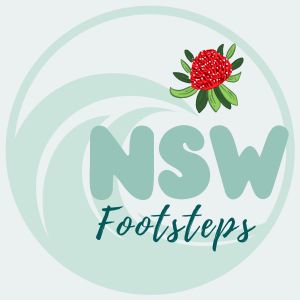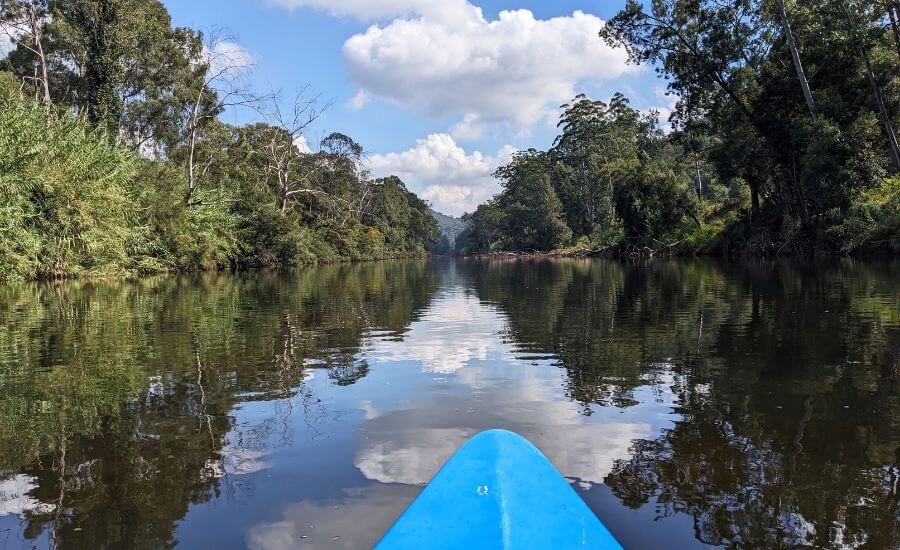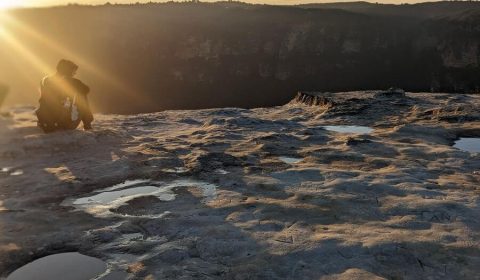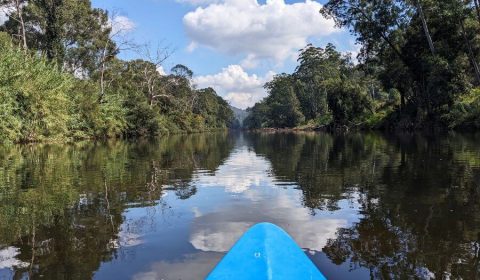Can you imagine a river that feels incredibly remote and wild, carving its way through rugged sandstone gorges, yet it’s practically on Sydney’s doorstep? Meet the Colo River!
Located just north-west of Sydney, this stunning waterway forms the northern boundary of the vast Wollemi National Park (part of the Greater Blue Mountains World Heritage Area). It eventually winds its way down as a tributary to join the mighty Hawkesbury River near Lower Portland.
We’ve had the pleasure of exploring different sections of the Colo with our trusty canoe, and honestly, every single trip was a delight. So, consider this your go-to guide! We’ve packed it with everything we learned, plus some fantastic advice shared by friendly local kayakers we met along the way. (Seriously, people just come up to share tips to make your paddle better – gotta love that Aussie spirit!).
So, what makes the Color River great for canoeing?
For starters, the scenery is absolutely spectacular. Picture this: towering sandstone cliffs draped in native bushland, with secluded sandy beaches popping up that are just perfect for a lunch break or stretching your legs.
And while you’ll feel completely immersed in pristine wilderness, getting there is surprisingly straightforward, with several access points serving the lower, central, and upper sections of the river. Another huge plus? The Colo caters to different skill levels – even enthusiastic beginners like us felt right at home on certain stretches!
The lower sections, especially as you get closer to the Hawkesbury confluence, offer lovely calm, flatwater paddling. This is perfect for a relaxed day trip or if you’re just starting out. Head further upstream, especially into the Colo Gorge, and things get more adventurous. You’ll find more challenging sections with potential rapids (their difficulty really depends on recent rain). We haven’t tackled this wilder part ourselves – it’s definitely territory for experienced paddlers on multi-day expeditions.
Our own adventures focused on the lower and central sections. They were incredibly scenic and mostly delightful, though they threw us a few challenges too! Why? Because – and this genuinely surprised us – much of the Colo river is tidal! Timing your paddle with the tides can make a big difference.
Wait, the Colo River is tidal? What does that even mean?
Okay, let’s talk tides! If you grew up near the coast, the idea of a tidal river might be old hat. But if not, here’s the scoop: these rivers actually flow both ways depending on the ocean tides! Their water levels rise and fall twice a day, just like the sea. Basically, any river connected to a bay or the ocean gets pushed around by the tides, and the closer you are to the coast, the stronger the effect. How far inland this tidal tango reaches varies from river to river – geology and the network of connecting channels can make things interesting.
Now, here’s where the Colo River threw us a curveball. Looking at a map, it doesn’t seem that close to the ocean, right? It flows into the Hawkesbury River first, which then meanders quite a distance, gathering water from other rivers before finally reaching Broken Bay and the sea. Yet, surprise! The Colo, just like the Hawkesbury it feeds, is tidal. We found there’s about a 30-minute delay compared to coastal tide times on the lower and central sections, and the water level can swing by about 1.5 meters (around 5 feet) between high and low tide!
Paddling with the tides on the Colo
So, how does this affect your canoeing trip? Simple: you want to paddle with the current whenever possible! It makes life so much easier. How do you know which way it’s going? First, check the tide times for a nearby spot, adjusting for that ~30 min delay.
Decoding the tides:
- Falling tide: water is flowing out towards the sea (downstream towards the Hawkesbury). Expect lower water levels and a helpful current in that direction.
- Rising tide: water is flowing in from the sea (upstream, away from the Hawkesbury). Expect higher water levels and a helpful current in that direction.
- Slack tide (high/low): around the exact high and low tide marks, the current briefly stops or slows down before reversing. This can be a good time to cross wider sections or navigate tricky spots.
The catch: currents & water levels
Sounds easy? Well, there are a couple more things to keep in mind:
- Current speed: while you know the direction, predicting the speed of the tidal current is tricky without local knowledge. It’s usually strongest about halfway between high and low tide. Be prepared for it to pick up!
- Water depth: low tide means lower water levels – obvious, right? But on the Colo, this can expose shallow sections or sandbars, especially upstream of the Colo River Bridge (Putty Road). If you paddle far into a shallow area on a high tide, you risk getting stranded as the water drops! (Keep in mind that recent rainfall also affects the overall river depth, adding another variable).
Our tidal tale on the Colo
So, how did this play out for us? We learned the hard way! Trying to paddle upstream from the Colo River Bridge (Putty Road) on a falling tide, we only made it about 2 km before our paddles were constantly hitting the riverbed. We decided to turn back rather than fight it.
Downstream of the bridge, the river is generally deeper, but even there, we had to navigate carefully around newly exposed sandbars as the tide went out.
So, can you actually paddle against the tide on the Colo?
Ha! After reading about all those factors messing with the currents, you’ve probably guessed the answer isn’t a simple ‘yes’ or ‘no’. It really depends on the specific conditions that day, and let’s be honest, how much power you’ve got in those paddling arms!
We actually did paddle against the tide for a while on the Colo. It’s doable… for a bit. But trust us, you really don’t want to plan your whole trip around fighting the current. It’s seriously tiring and pretty much guarantees you’ll be focusing more on the burn in your shoulders than the beautiful scenery whizzing (or rather, crawling) by. It just takes the easy delight out of the paddle.
Luckily, the Colo River is generous with its lovely sandy beaches along the banks. If you find yourself battling the current and feeling like you’re paddling through treacle, just pull over! It’s the perfect excuse to land your canoe, grab a snack, have a rest, and simply wait for the current to ease up or change direction. Problem solved!
Where can you actually launch your canoe on the Colo River?
Alright, let’s talk logistics! Finding the perfect spot to slide your canoe into the Colo isn’t always straightforward. First things first: water levels are key. They can change dramatically, especially after rain, affecting how easy it is to navigate and even access the riverbank at certain points. (You gotta love Mother Nature keeping us on our toes here in Australia!)
So, Rule #1: Always check current conditions before you head out. A good starting point is the NPWS website for any alerts concerning Wollemi National Park or relevant reserves.
With that crucial step covered, let’s dive into the main launch spots we know about:
Colo River Park
- Location: -33.43289, 150.82826 (under the Putty Road Bridge)
- Best: for the central section of the river
It’s the best canoe launch overall, because you can paddle both upstream and downstream. There’s a newly built launch platform specifically designed for kayaks and canoes (note: not a boat ramp for trailers). The park has toilets, bins and picnic tables.
Lower Portland Public Boat Ramp
- Location: -33.43672, 150.88568
- Best: for Lower Colo River
It’s not the same as the Lower Portland Ferry Boat Ramp – that’s not accessible when the ferry operates. Go past “the bridge to Nowhere”, then turn off to Skeleton Rocks Reserve. The public boat ramp is about 100 metres past the bridge, accessible on a dirt track.
Upper Colo Bridge
- Location: -33.41167, 150.73816
- Best: for Upper Colo River
There’s a small park with water access on the western side of the bridge. However, there’s no fancy ramp or dedicated launch platform here. You’ll need to carry your canoe or kayak down a short slope to the river. There’s no facilities either.
The water level on this upper section can be too low for paddling during dry spells. We encountered ankle deep water and giant sandbars, suitable for kids splashing around, but not paddling.
Upper Colo Reserve and campground
- Location: -33.42086, 150.73236
- Best: for Upper Colo River
There’s public access to the Upper Colo River. However, if you’re not camping here, be prepared for a potentially steep walk of a few hundred meters to reach the river from the public access areas. Campers generally have vehicle access closer to the river within the reserve.
What about other spots?
- Private properties: you might see potential access points on maps that look tempting, but many riverfront areas are private land. Some private campgrounds might offer river access to paying guests (always ask and arrange permission first!).
- Respect boundaries: please don’t just assume access is public. Always stick to designated public launch points or get explicit permission to avoid trespassing.
Colo River paddling map
To help you visualize it, here’s a map showing the potential launch spots and the routes we paddled:
Extend your Colo adventure: where to stay nearby
Depending on where you’re based in Sydney, tackling the Colo as a day trip is definitely doable. But if you want to really soak in the wilderness vibe and stay overnight, you’re in luck! There are some great camping options nearby, plus a few (very few!) cozy spots if you prefer solid walls around you.
Tiny Thomas (Upper Colo)
Fancy a comfy cabin escape? Tiny Thomas in Upper Colo offers just that, complete with a kitchen and bathroom, all surrounded by gorgeous nature. Think giant windows looking out onto the river and evenings spent by the campfire. Sounds pretty idyllic!
Bielany Campground (Upper Colo)
Located right on the banks of the beautiful Colo River in Upper Colo, Bielany is a small campground run by the Polish Foundation. It offers handy facilities like toilets and hot showers, plus that all-important river access for campers.
Wheeny Creek campground (Wollemi National Park)
For a peaceful, back-to-basics experience, check out Wheeny Creek campground within Wollemi National Park. Facilities are simple (think toilets, wood BBQs, no marked sites, BYO drinking water), but the setting under towering eucalyptus trees right beside Wheeny Creek is lovely. The creek itself is shallow – perfect for kids to splash in, but too shallow for paddling further up.
Good to know: The final few kilometres to the campground are on a winding unsealed road, usually fine for regular cars in decent weather, but take it slow.
Our final verdict: is canoeing the Colo River worth it?
Absolutely, 100% yes!
The Colo River truly is a special gem. Finding this kind of genuine wilderness feel – the towering sandstone cliffs, the quiet sandy beaches, the feeling of being miles from anywhere – so incredibly close to a major city like Sydney is pretty rare and totally worth experiencing.
What we loved most was the variety. One minute you can be drifting peacefully on a calm, mirror-like stretch, just soaking in the sounds of the bush. The next, you might be navigating around a sandbar revealed by the tide or feeling the pull of the current (remember those tides!). While we stuck to the more accessible lower and central sections, perfect for day trips and paddlers like us, the river clearly holds more rugged adventures upstream for those with the skills and gear for multi-day expeditions through the gorge.
Yes, you need to plan a bit – checking water levels, understanding the tides, and choosing the right launch spot is key. But the reward is immense. It’s a chance to disconnect, immerse yourself in stunning natural beauty, and enjoy a fantastic day (or more!) out on the water.
Whether you’re looking for a relaxed family paddle exploring the lower reaches or a more challenging adventure further upstream, the Colo River delivers an unforgettable canoeing experience.
Have you paddled the Colo? Got any tips to share? Let us know in the comments below!














Leave a Reply